
Europe and Mediterranean: Adriatic with Greece & Italy Cruise
Princess Cruises
Once home to ancient civilizations and famous philosophers, the Mediterranean continues to define tradition. Depart from Rome to explore Pompeii's ruins while visiting Naples and get a taste of handpicked local produce in Corfu.

Executive Member Benefit
Executive Members receive an annual 2% Reward, up to $1,250, on qualified Costco Travel purchases
Digital Costco Shop Card
Member Exclusive: Digital Costco Shop Card with every Princess Cruises® sailing†
Sailing Itinerary

Note: Cruise itineraries are subject to change. Please verify ports and times directly with the cruise line.
Overview
Located about 80 kilometers northwest of Rome, the Port of Civitavecchia is the port of Rome and a busy ferry and cargo port serving Italy and southern Europe. Lying on Italy’s eastern shores on the Tyrrhenian Sea, the Port of Civitavecchia has excellent direct connections to Rome. It is an important cruise and ferry port with regular passage to Sardinia, Malta, Sicily, Tunis, and Barcelona. Fishing is of secondary importance to the Port of Civitavecchia. In addition to ocean-going traffic, the Port of Civitavecchia also contains a thermoelectric center and metallurgical works. In 2006, over 51 thousand people called the Port of Civitavecchia home. The Port of Civitavecchia was built on an earlier Etruscan settlement. Emperor Trajan founded the Port of Civitavecchia in the early 2nd Century, calling it Centumcellae. Today, Trajan’s Port is preserved within today’s Port of Civitavecchia. A busy growing town during the late Roman era, the Port of Civitavecchia was attacked by Vandals and then destroyed by the Saracens in 828 AD. Residents escaped to the nearby Allumiere Mountains where Pope Leo IV built a walled town in 854. Eventually, the people returned to Civitavecchia (the name means “old city”). At the end of the 15th Century, the Port of Civitavecchia was under frequent attack by pirates. The naval arsenal was constructed in 1508. Pope Paul III commissioned the building of the keep, which was designed by Donato Bramante and then finished by Michelangelo in 1537, to protect the Port of Civitavecchia from pirate attacks. In 1696, Civitavecchia became a free port under Pope Innocent XII. Because it was Rome’s main port, the French occupied the Port of Civitavecchia in 1849. The Port of Civitavecchia was linked to Rome by the Rome and Civitavecchia Rail Road in 1859. When the Port of Civitavecchia became part of the Kingdom of Italy in 1870, it was one of the Papal State’s most strongly fortified towns when Papal troops welcomed General Nino Bixio on behalf of the Italian unification forces into the Port of Civitavecchia fortress. World War II brought destruction to as much as three-quarters of the Port of Civitavecchia. Reconstruction enlarged the Port of Civitavecchia beyond its pre-war area. The Authority Portuale Civitavecchia (Port of Rome) is responsible for managing and operating the Port of Civitavecchia as well as the ports of Fiumicino and Gaeta. The modern Port of Civitavecchia is at the center of rail, road, and air networks that link it with central Italy and the world. The Port of Civitavecchia can handle about 11 million tons of cargo per year and over 1.5 million passengers. Cargoes include forest products, cereals, iron and steel, chemicals, automobiles, containers, and liquid bulk. In 2007, the Port of Civitavecchia welcomed 856 cruise vessels carrying 1.6 million passengers, and the total number of passengers using ferries and cruise vessels was 3.8 million. In 2007, the Port of Civitavecchia handled a total of 7.7 million tons of cargo. This total included 1.5 million tons of liquid bulk, 1.7 million tons of solid bulk, 4.6 million tons of packages, and 31.1 thousand TEUs of containerized cargo. The Port of Civitavecchia contains 28 berths of a total of 5.6 thousand meters in length alongside depths from 6 to 18 meters. Port properties include five warehouses containing 36 thousand square meters for handling and storing cargo. The intermodal terminal includes seven thousand square meters of storage space and 12.5 thousand square meters for loading/unloading rail cars and parking. The Port of Civitavecchia is one of the busiest ferry ports in the world. Just 80 kilometers northwest of Rome, it is the main tourist destination for people traveling to the Eternal City. It is also a central port for ferries carrying passengers to more local destinations. The ferry terminal offers a complete line of amenities. Different ferry companies offer services to various destinations. Moby Lines handles crossings to Olbia, Sardinia. Corsica Sardinia Ferries runs services to Golfo Aranci. Grimaldi Ferries carries passengers to Barcelona and Tunis, and Grand Navi Veloci operates a route to Tunis. Ferrovie dello Stato operates a combined rail-ferry service to Golfo Aranci.
Overview
The beautiful city of Saranda offers a unique atmosphere and style that steels the hearts of all its visitors. The sea panorama, and he variety of flora, favored by the soft climate, make Saranda the preferred center for rest and recreation and an important tourist town. Most Albanian couples come to spend their hhoneymooninin Saranda. That's why it is known in Albania as the town of the honeymooners. Saranda is situated in an open sea gulf, opposite the island of Corfu (Greece). Saranda is an animated town between the mountains and the Ionian Sea, 61km southwest of Gjirokastra. There are today, daily ferry services to and from Corfu. Saranda is rapidly developing into the southern gateway for tourism into Albania. In the year 2000, Saranda was visited by 50thousand foreign tourists and many more Albanian tourists. Near Saranda stood the ancient Illyrian city of Onchesmos, mentioned as a port in the 1st century B.C. In the 4th century A.C. the town was fortified with walls. Inside the walls have been excavated the remains of dwellings, water cisterns, and an early Christian Basilica of the 5th and 6th century, containing a beautiful multicolored floor mosaic. Other mosaics are to be found in the district museum. The ruins are also preserved of an early Christian Monastery, of the 40 Saints, from which the modern name of the town (Saranda) is derived.
Overview
Almost 25km. Ancient Olympia is located in the medieval Katakolo, in the district of ancient Pheia, which is, known today as the port of Pirgos, the capital of our prefecture. Katakolo is a small town, with many shops, bars, and good fish taverns, with fresh and tasty fish. The bay of Agios Andreas is located next to Katakolo, on the top of a hill, and the ruins of Pontikokastro, a very strong fort in the past, the period of Villehardouins. At Agios Andreas, everyone can enjoy coffee or a drink, admiring the sea and the gorgeous sunset.
Overview
If you've ever wondered what sort of prize you'd get for saving Europe, look no further than Valletta. Named after La Valette, the Grandmaster who masterminded Malta's successful stand against the Turkish siege of 1565, Valletta became the city of the Knights of the Order of St John and the seat of Malta's government. While traveling through the Mediterranean, Sir Walter Scott described Valletta as 'the city built by gentlemen for gentlemen'. Today it's a beautifully preserved 16th-century walled city, small enough to cover in a few hours without sweating too much in the Mediterranean sun. The streets were carefully laid out to channel cool breezes in from the harbour. Situated on the northeast coast of Malta, Valletta is the capital and is built on the promontory of Mount Sciberras which juts out into the middle of a bay. This dissects the bay into two deep harbors: the Grand Harbour to the east and the Marsamxett to the west. Valletta is a rough rectangle at the tip of a peninsula on the coast, just a few hundred meters across in either direction, and thus surrounded by water on its northern, eastern, and southern sides. The city was named after Jean Parisot de la Valette who was the Grand Master of the Order of the Knight Hospitallers (Knights of Saint John of Jerusalem). This famed religious order of hospitallers was founded in Jerusalem in the 11th century and made their base in Malta after they were expelled from Rhodes by the Ottoman Turks. During the time of Grand Master La Valette, in 1565, the Knights and the Maltese managed to suppress a siege on the island by the forces of Süleyman the Magnificent, Sultan of the Ottoman Empire in what was to become known as one of history's greatest sieges. Following the siege, the building of the city began in the same year 1565 to create a base for the defense of the island. Although Grand Master La Valette managed to lay the first stone, he died before its completion. Most of the embellishments of Valletta were done during the time of Grand Master La Cassiere, especially the magnificent St John's Co-Cathedral. The reign of the Knights of St John eventually came to an end with the successful invasion by Napoleon who occupied Malta on his way to Egypt. A Maltese revolt against the French garrison was the catalyst for the occupation of Valletta by the British in 1800. Valetta is also the spot where the Italian fleet surrendered to the Allies in 1943. Valletta's network of streets is laid out in an orthogonal grid dominated by a main artery that crosses the length of the entire city and opens up into a series of squares at its geometric center, around the Palace of the Grand Masters. The city architecture is inspired by Italian Renaissance planning principles and served as an early model of urban design. Valletta is one of the most important planned towns of the Renaissance. It equals in its noble architecture, any capital in Europe, while its timeless beauty and artistic treasures make it a well-deserved World Heritage site. There are several superb museums here as well as historical sites that are worth visiting. The main thoroughfare in the city is Republic Street. You'll find all the main shops and character-filled side streets leading off from here. For those interested in shopping, Merchant's Street and Lucia Street are the places to go for the most interesting merchandise. Lucia Street is famous for the exquisite silver and gold filigree jewelry sold there. Merchant Street specializes in souvenirs and is also home to a large open market.
Overview
Catania is an ancient port city on Sicily's east coast. It sits at the foot of Mt. Etna, an active volcano with trails leading up to the summit. The city's wide central square, Piazza del Duomo, features the whimsical Fontana dell'Elefante statue and richly decorated Catania Cathedral. In the southwest corner of the square, La Pescheria's weekday fish market is a rowdy spectacle surrounded by seafood restaurants.
Overview
Naples, a city in southern Italy, sits on the Bay of Naples. Nearby is Mount Vesuvius, the still-active volcano that destroyed the nearby Roman town of Pompeii. Dating to the 2nd millennium B.C., Naples has centuries of important art and architecture. The city's cathedral, the Duomo di San Gennaro, is filled with frescoes. Other major landmarks include the lavish Royal Palace and Castel Nuovo, a 13th-century castle.
Overview
Located about 80 kilometers northwest of Rome, the Port of Civitavecchia is the port of Rome and a busy ferry and cargo port serving Italy and southern Europe. Lying on Italy’s eastern shores on the Tyrrhenian Sea, the Port of Civitavecchia has excellent direct connections to Rome. It is an important cruise and ferry port with regular passage to Sardinia, Malta, Sicily, Tunis, and Barcelona. Fishing is of secondary importance to the Port of Civitavecchia. In addition to ocean-going traffic, the Port of Civitavecchia also contains a thermoelectric center and metallurgical works. In 2006, over 51 thousand people called the Port of Civitavecchia home. The Port of Civitavecchia was built on an earlier Etruscan settlement. Emperor Trajan founded the Port of Civitavecchia in the early 2nd Century, calling it Centumcellae. Today, Trajan’s Port is preserved within today’s Port of Civitavecchia. A busy growing town during the late Roman era, the Port of Civitavecchia was attacked by Vandals and then destroyed by the Saracens in 828 AD. Residents escaped to the nearby Allumiere Mountains where Pope Leo IV built a walled town in 854. Eventually, the people returned to Civitavecchia (the name means “old city”). At the end of the 15th Century, the Port of Civitavecchia was under frequent attack by pirates. The naval arsenal was constructed in 1508. Pope Paul III commissioned the building of the keep, which was designed by Donato Bramante and then finished by Michelangelo in 1537, to protect the Port of Civitavecchia from pirate attacks. In 1696, Civitavecchia became a free port under Pope Innocent XII. Because it was Rome’s main port, the French occupied the Port of Civitavecchia in 1849. The Port of Civitavecchia was linked to Rome by the Rome and Civitavecchia Rail Road in 1859. When the Port of Civitavecchia became part of the Kingdom of Italy in 1870, it was one of the Papal State’s most strongly fortified towns when Papal troops welcomed General Nino Bixio on behalf of the Italian unification forces into the Port of Civitavecchia fortress. World War II brought destruction to as much as three-quarters of the Port of Civitavecchia. Reconstruction enlarged the Port of Civitavecchia beyond its pre-war area. The Authority Portuale Civitavecchia (Port of Rome) is responsible for managing and operating the Port of Civitavecchia as well as the ports of Fiumicino and Gaeta. The modern Port of Civitavecchia is at the center of rail, road, and air networks that link it with central Italy and the world. The Port of Civitavecchia can handle about 11 million tons of cargo per year and over 1.5 million passengers. Cargoes include forest products, cereals, iron and steel, chemicals, automobiles, containers, and liquid bulk. In 2007, the Port of Civitavecchia welcomed 856 cruise vessels carrying 1.6 million passengers, and the total number of passengers using ferries and cruise vessels was 3.8 million. In 2007, the Port of Civitavecchia handled a total of 7.7 million tons of cargo. This total included 1.5 million tons of liquid bulk, 1.7 million tons of solid bulk, 4.6 million tons of packages, and 31.1 thousand TEUs of containerized cargo. The Port of Civitavecchia contains 28 berths of a total of 5.6 thousand meters in length alongside depths from 6 to 18 meters. Port properties include five warehouses containing 36 thousand square meters for handling and storing cargo. The intermodal terminal includes seven thousand square meters of storage space and 12.5 thousand square meters for loading/unloading rail cars and parking. The Port of Civitavecchia is one of the busiest ferry ports in the world. Just 80 kilometers northwest of Rome, it is the main tourist destination for people traveling to the Eternal City. It is also a central port for ferries carrying passengers to more local destinations. The ferry terminal offers a complete line of amenities. Different ferry companies offer services to various destinations. Moby Lines handles crossings to Olbia, Sardinia. Corsica Sardinia Ferries runs services to Golfo Aranci. Grimaldi Ferries carries passengers to Barcelona and Tunis, and Grand Navi Veloci operates a route to Tunis. Ferrovie dello Stato operates a combined rail-ferry service to Golfo Aranci.
Onboard the Sapphire Princess
Sapphire Princess
Year Built: 2004
Year Refurbished: 2023
Double Occupancy Capacity: 2674
Swim in one of four sparkling pools, shop the boutiques or get a massage in the Lotus Spa®. Dine casually on pizza and burgers or more elegantly in one of the many formal dining rooms and specialty restaurants. And with nearly 750 balcony staterooms, there's a room with a view for you.
Activities & Services (included in cruise)

Show Lounge
- Card Room
- Casino
- Disco/Nightclub
- Game Arcade
- Movies Under the Stars®
- Theater/Show Lounge
- Beauty Salon
- Fitness Center
- Fitness Classes
- Miniature Golf
- Pool - Adults Only
- Pool - Children's
- Pool - Outdoor
- Pool - Indoor
- Sports Facilities
- Whirlpool/Jacuzzi
- Art Gallery
- Bars/Lounges
- Library
- Children's Indoor Play Area
- Children's Outdoor Play Area
- Educational Classes
- Organized Age Specific Activities
- Teen Center or Disco
- Teen Programs
- Business Center
- Duty-Free Shops/Boutiques
- Elevators
- Infirmary/Medical Center
- Religious Services
- Self-Service Laundromat
- Wedding/Vow Renewal
Activities & Services (available for an extra fee)

Full-Service Spa
- Full-Service Spa
- Spa Services/Massage
- Sauna/Steam Room
- Educational Programs
- Internet Center
- Babysitting
- Dry Cleaning/ Laundry Service

Dining Room
Main Dining
International Dining Room: After final payment, through the MedallionClass® app, you may request your dining preference with Dine My Way℠. Customize your dining experiences nightly by choosing your seating time, dining companions and dietary needs.
Pacific Moon Dining Room: After final payment, through the MedallionClass® app, you may request your dining preference with Dine My Way℠. Customize your dining experiences nightly by choosing your seating time, dining companions and dietary needs.
Santa Fe Dining Room: After final payment, through the MedallionClass® app, you may request your dining preference with Dine My Way℠. Customize your dining experiences nightly by choosing your seating time, dining companions and dietary needs.
Savoy Dining Room: After final payment, through the MedallionClass® app, you may request your dining preference with Dine My Way℠. Customize your dining experiences nightly by choosing your seating time, dining companions and dietary needs.
Vivaldi Dining Room: After final payment, through the MedallionClass® app, you may request your dining preference with Dine My Way℠. Customize your dining experiences nightly by choosing your seating time, dining companions and dietary needs.

Sabatini's
Specialty Dining
Chef’s Table Experience: Taking dining to a new level, the Chef’s Table Experience includes pre-dinner cocktails and hors d’oeuvres in the galley for you and a limited number of fellow guests. After your executive chef describes the specially designed menu for the night, participants are escorted to an intimate table for the main course, including pairing suggestions. This restaurant is available for an additional cost. Limited capacity, reservations required.
Sabatini's℠: An upscale authentic Italian dining experience in a remarkable eight-course meal. The menu features both local seafood specialties and other regional favorites. This restaurant is available for an additional cost.
Sterling Steakhouse℠: An upscale and more refined approach to the traditional steakhouse, this venue features some of the best, most tender cuts of beef, such as New York and porterhouse, plus a prime rib carving station. This restaurant is available for an additional cost.
Vines: Vines boasts an extensive collection of wines, like Opus One, Super Tuscans, fine sparkling wines and regional offerings for purchase. The menu also includes wine flights and a selection of wines by the glass.
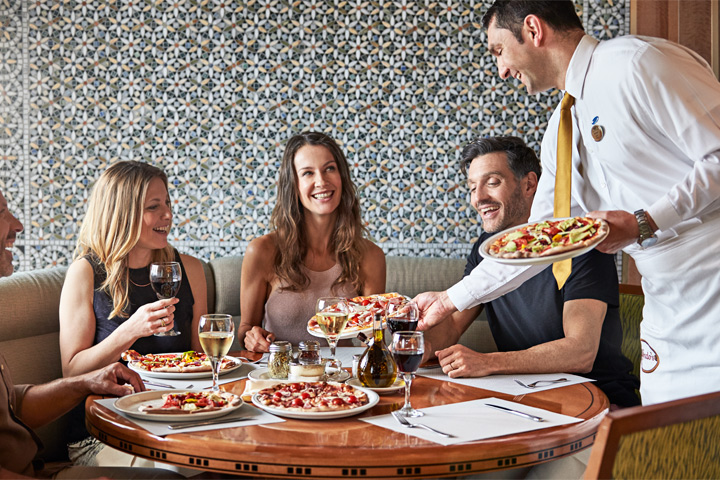
Alfredo's Pizzeria
Casual Dining
Alfredo's Pizzeria: This charming sit-down venue offers an enticing menu of freshly prepared individual-size pizzas along with beer and wines by the glass. The open kitchen design allows you to watch as the chefs create pizza by hand and serve them straight out of the oven.
Horizon Court: Horizon Court offers a buffet selection that changes throughout the day to satisfy the most discriminating palate. Indulge in a delightful array of worldwide cuisine, freshly baked breads and regional comfort foods, in a casual setting at breakfast, lunch or dinner. Enjoy fresh fruits, signature pastas and desserts galore along with your favorite beverages and customizable features like create-your-own salads and sandwiches.
International Café: Open 24 hours a day, the International Café located in the Piazza is the place for an ever-changing array of small bite meals, treats and gourmet beverages. Grab a freshly baked croissant to start your day, snack on pies and quiche or choose from a wide variety of salads and sandwiches at lunchtime, and indulge in decadent desserts in the evening. Coffee and tea fans will love the New Grounds Crafted Coffee menu featuring a variety of specialty espresso-based drinks made from a custom blend of coffee beans, as well as iced tea fusions.
Trident Grill: Follow your nose to the Trident Grill where the burgers are flipping and the hotdogs roasting, served with a variety of fixin’s and crisp fries. Veggie burgers, bratwurst and grilled chicken breast are also served and all are sure to hit the spot when you are relaxing out on deck.
Room Service: Call for room service delivery or order through OceanNow® in the Princess® MedallionClass® app at any time of the day or night. Guests with the latest Princess Plus and Princess Premier packages enjoy OceanNow® and room service delivery with no charge. Otherwise, a one-time access fee of $14.99 per person per voyage will apply for OceanNow® delivery and a $5 room service fee will apply for each order placed by stateroom phone. To order, guests can press the "Room Service" button on their stateroom phone, or order through OceanNow®.
Staterooms feature a refrigerator, spacious closet and bathroom with shower.
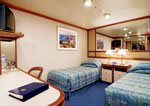
Category: IA
Approximately 168 sq. ft., this well-appointed interior stateroom provides fine amenities.

Category: IB
Approximately 168 to 182 sq. ft., this well-appointed interior stateroom provides fine amenities.

Category: IC
Approximately 168 to 182 sq. ft., this well-appointed interior stateroom provides fine amenities.

Category: ID
Approximately 168 sq. ft., this well-appointed interior stateroom provides fine amenities.

Category: IE
Approximately 168 sq. ft., this well-appointed interior stateroom provides fine amenities.

Category: IF
Approximately 168 sq. ft., this well-appointed interior stateroom provides fine amenities.
Nicely-appointed staterooms feature a picture window, spacious closet and bathroom with shower.
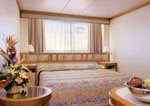
Category: O5
Approximately 200 sq. ft., this well-appointed stateroom features a forward-facing cabin for memorable views.

Category: OC
Approximately 183 to 194 sq. ft., this well-appointed stateroom features a picture window for memorable views.

Category: OF
Approximately 183 to 194 sq. ft., this well-appointed stateroom features a picture window for memorable views.

Category: OV
Approximately 183 sq. ft., this well-appointed stateroom features a picture window with an obstructed view.

Category: OW
Approximately 183 sq. ft., this well-appointed stateroom features a picture window with an obstructed view.

Category: OY
Approximately 183 sq. ft., this well-appointed stateroom features a picture window with an obstructed view.

Category: OZ
Approximately 183 sq. ft., this well-appointed stateroom features a picture window with an obstructed view.
Staterooms feature a private balcony, spacious walk-in closet, desk and bathroom with shower.
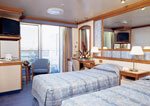
Category: B2
Approximately 277 sq. ft. including balcony, this cabin provides outstanding views from a private balcony.

Category: B4
Approximately 237 to 277 sq. ft. including balcony, this cabin provides dramatic wake views from a rear-facing private balcony.

Category: BA
Approximately 237 sq. ft. including balcony, this cabin provides outstanding views from a private balcony.

Category: BB
Approximately 237 sq. ft. including balcony, this cabin provides outstanding views from a private balcony.

Category: BC
Approximately 237 sq. ft. including balcony, this cabin provides outstanding views from a private balcony.

Category: BD
Approximately 237 to 277 sq. ft. including balcony, this cabin provides outstanding views from a private balcony.

Category: BE
Approximately 237 to 277 sq. ft. including balcony, this cabin provides outstanding views from a private balcony.

Category: BF
Approximately 237 sq. ft. including balcony, this cabin provides outstanding views from a private balcony.
Features private balcony and sitting room, two TVs, walk-in closet and bathroom with tub and shower.
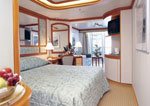
Category: M1
Approximately 354 sq. ft. including balcony, this spacious cabin provides a seating area with sofa bed, and full bath with combination tub and shower.

Category: MB
Approximately 354 sq. ft. including balcony, this spacious cabin provides a seating area with sofa bed, and full bath with combination tub and shower.

Category: MD
Approximately 354 sq. ft. including balcony, this spacious cabin provides a seating area with sofa bed, and full bath with combination tub and shower.

Category: ME
Approximately 354 sq. ft. including balcony, this spacious cabin provides a seating area with sofa bed, and full bath with combination tub and shower.
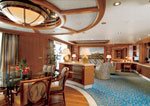
Category: S1
Approximately 1,329 sq. ft. including balcony, the Grand Suite features an expansive cabin and oversized aft-facing balcony. Enjoy exclusive suite-only upgrades and benefits.
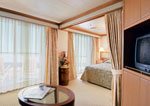
Category: S2
Approximately 692 sq. ft. including balcony, the Owner's Suite features an expansive cabin and oversized aft-facing balcony. Enjoy exclusive suite-only upgrades and benefits.

Category: S3
Approximately 525 to 572 sq. ft. including balcony, the Penthouse Suite features a spacious cabin and aft-facing balcony. Enjoy exclusive suite-only upgrades and benefits.

Category: S4
Approximately 555 sq. ft. including balcony, the Penthouse Suite features a spacious cabin and separate seating area with a sofa bed. Enjoy exclusive suite-only upgrades and benefits.

Category: S5
Approximately 705 sq. ft. including balcony, the Premium Suite features a spacious cabin and separate seating area with a sofa bed. Enjoy exclusive suite-only upgrades and benefits.

Category: S6
Approximately 525 to 548 sq. ft. including balcony, the Vista Suite features a spacious cabin and aft-facing balcony. Enjoy exclusive suite-only upgrades and benefits.

Category: S8
Approximately 613 sq. ft. including balcony, the Two Bedroom Family Suite features 2 bedrooms to accommodate up to 6 passengers. Enjoy exclusive suite-only upgrades and benefits.

| Symbol | Description |
|---|---|
 | Two-bedroom family suite (connecting staterooms with private balcony, accommodate up to six persons) |
 | Will accommodate third person |
 | Two lower beds not convertible to queen, shower only |
 | Queen bed not convertible to two twin beds |
 | Balcony access when in port only |
 | Will accommodate third and fourth person |
 | Connecting staterooms |
 | Fully accessible stateroom, roll-in shower only |
 | Will accommodate third and fourth person, fourth berth is a rollaway bed |
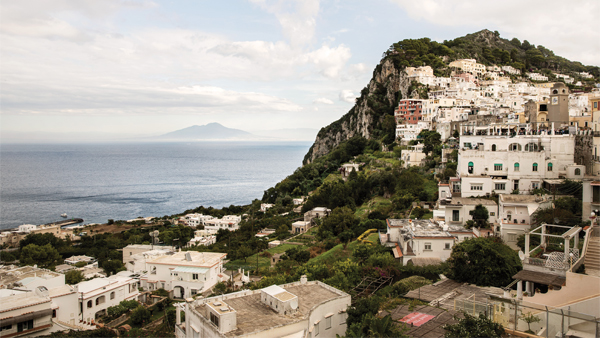
- Ship Name: Sapphire Princess
- Year Built: 2004
- Year Refurbished: 2023
- Year Entered Present Fleet: 2004
- Ship Class: Diamond
- Maximum Capacity: 2,670
- Number of Passenger Decks: 18
- Number of Crew: 1,100
- Officers' Nationality: British/Italian
- Ocean-View without Balcony: 216
- Ocean-View with Balcony: 522
- Total Inside Staterooms: 366
- Tonnage (GRT): 115,875
- Capacity Based on Double Occupancy: 2,674
- Country of Registry: Bermuda
- Total Staterooms: 1,337
- Suites with Balcony: 214
- Crew/Hotel Staff Nationality: International
Costco Member Reviews

Available Dates & Prices
Terms & Conditions
*Price shown is per person based on double occupancy and is valid for select stateroom categories only. Click on the Terms & Conditions link below for details.
†One Digital Costco Shop Card per room/stateroom, per stay. The exact amount of the Digital Costco Shop Card will be calculated during the booking process. The Digital Costco Shop Card promotion is nontransferable and may not be combined with any other promotion. A Digital Costco Shop Card will arrive by email approximately 10 days after the start of your cruise. Click on the Terms & Conditions link below for additional information.
Ship's registry: © Princess Cruise Lines, Ltd. Ships of Bermudan and British registry
Digital Costco Shop Card













